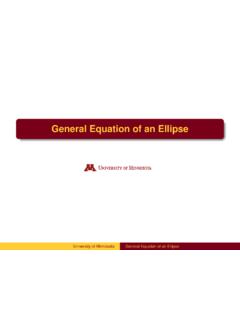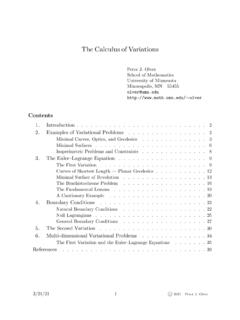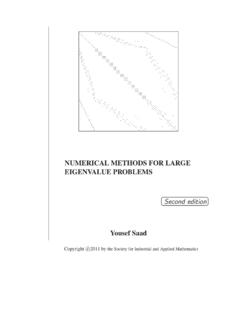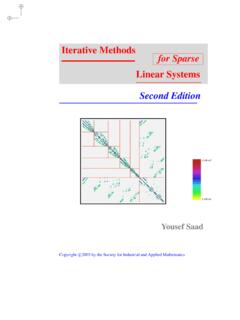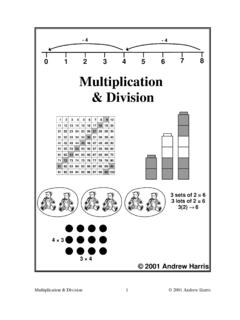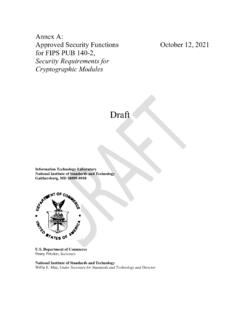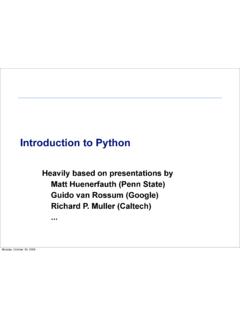Transcription of Cluster Analysis: Basic Concepts and Algorithms
1 K 7. Cluster Analysis: Basic Concepts and Algorithms Cluster analysis divides data into groups (clusters) that are meaningful, useful, or both. If meaningful groups are the goal, then the clusters should capture the k natural structure of the data. In some cases, however, Cluster analysis is used k for data summarization in order to reduce the size of the data. Whether for understanding or utility, Cluster analysis has long played an important role in a wide variety of elds: psychology and other social sciences, biology, statistics, pattern recognition, information retrieval, machine learning, and data mining.
2 There have been many applications of Cluster analysis to practical prob- lems. We provide some speci c examples, organized by whether the purpose of the clustering is understanding or utility. Clustering for Understanding Classes, or conceptually meaningful groups of objects that share common characteristics, play an important role in how people analyze and describe the world. Indeed, human beings are skilled at dividing objects into groups (clustering) and assigning particular objects to these groups (classi cation). For example, even relatively young children can quickly label the objects in a photograph.
3 In the context of understanding data, clusters are potential classes and Cluster analysis is the study of tech- niques for automatically nding classes. The following are some examples: Biology. Biologists have spent many years creating a taxonomy (hi- erarchical classi cation) of all living things: kingdom, phylum, class, order, family, genus, and species. Thus, it is perhaps not surprising that k k 526 Chapter 7 Cluster Analysis: Basic Concepts and Algorithms much of the early work in Cluster analysis sought to create a discipline of mathematical taxonomy that could automatically nd such classi cation structures.
4 More recently, biologists have applied clustering to analyze the large amounts of genetic information that are now available. For example, clustering has been used to nd groups of genes that have similar functions. Information Retrieval. The World Wide Web consists of billions of web pages, and the results of a query to a search engine can return thousands of pages. Clustering can be used to group these search results into a small number of clusters, each of which captures a particular aspect of the query. For instance, a query of movie might return web pages grouped into categories such as reviews, trailers, stars, and theaters.
5 Each category ( Cluster ) can be broken into subcategories (sub- clusters), producing a hierarchical structure that further assists a user's exploration of the query results. Climate. Understanding the Earth's climate requires nding patterns in the atmosphere and ocean. To that end, Cluster analysis has been applied to nd patterns in atmospheric pressure and ocean temperature k that have a signi cant impact on climate. k Psychology and Medicine. An illness or condition frequently has a number of variations, and Cluster analysis can be used to identify these di erent subcategories.
6 For example, clustering has been used to identify di erent types of depression. Cluster analysis can also be used to detect patterns in the spatial or temporal distribution of a disease. Business. Businesses collect large amounts of information about current and potential customers. Clustering can be used to segment customers into a small number of groups for additional analysis and marketing activities. Clustering for Utility Cluster analysis provides an abstraction from in- dividual data objects to the clusters in which those data objects reside.
7 Ad- ditionally, some clustering techniques characterize each Cluster in terms of a Cluster prototype; , a data object that is representative of the objects in the Cluster . These Cluster prototypes can be used as the basis for a number of additional data analysis or data processing techniques. Therefore, in the context of utility, Cluster analysis is the study of techniques for nding the most representative Cluster prototypes. k k 527. Summarization. Many data analysis techniques, such as regression or principal component analysis, have a time or space complexity of O(m2 ).
8 Or higher (where m is the number of objects), and thus, are not practical for large data sets. However, instead of applying the algorithm to the entire data set, it can be applied to a reduced data set consisting only of Cluster prototypes. Depending on the type of analysis, the number of prototypes, and the accuracy with which the prototypes represent the data, the results can be comparable to those that would have been obtained if all the data could have been used. Compression. Cluster prototypes can also be used for data compres- sion.
9 In particular, a table is created that consists of the prototypes for each Cluster ; , each prototype is assigned an integer value that is its position (index) in the table. Each object is represented by the index of the prototype associated with its Cluster . This type of compression is known as vector quantization and is often applied to image, sound, and video data, where (1) many of the data objects are highly similar to one another, (2) some loss of information is acceptable, and (3) a substantial reduction in the data size is desired.
10 K E ciently Finding Nearest Neighbors. Finding nearest neighbors k can require computing the pairwise distance between all points. Often clusters and their Cluster prototypes can be found much more e ciently. If objects are relatively close to the prototype of their Cluster , then we can use the prototypes to reduce the number of distance computations that are necessary to nd the nearest neighbors of an object. Intuitively, if two Cluster prototypes are far apart, then the objects in the corre- sponding clusters cannot be nearest neighbors of each other.

